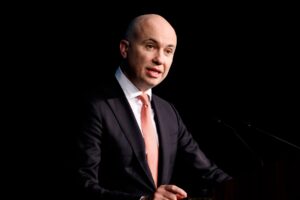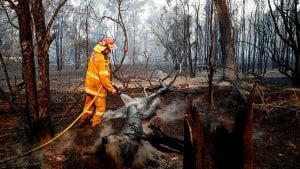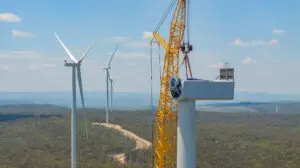NSW energy minister Penny Sharpe says she hopes that energy becomes boring, and that people in 2035 look back on the transition from coal and wonder what all the fuss was about.
In a lengthy interview for the latest episode of Renew Economy’s weekly Energy Insiders podcast, Sharpe says the task of navigating the country’s biggest and most coal dependent grid away from fossil fuels to renewables and storage is challenging.
And that’s because the technology choice are shifting from centralised coal and gas generators, to a distributed array of wind, solar, and storage, and because of the rise of consumer resources, such as rooftop solar, household batteries and EVs, that will play a critical, if not dominant role in the future grid.
Sharpe took over as energy minister from Liberal Matt Kean in 2023 after Labor won the state poll, and has inherited the infrastructure roadmap that seeks to get enough new wind, solar and storage built so that the state’s remaining and ageing coal fired generators can retire by 2035. Some will close sooner.
“We’re going from five large coal-fired power stations to literally 1,000s of individuals, or virtual power plants, where people their own little power stations, and then they’re coming in and out of the grid,” Sharpe says.
“My vision for this is for this to be as easy as possible for an individual who just wants to get home, turn on the lights, have the air con on when they want, and to be able to charge their car.
“I just want energy to be boring. People don’t care where it comes from, but we’re transforming this entire network into something that’s powered by the sun and by wind, and backed up with batteries, and you know, it’s, it’s a reliable system that people can afford and that’s easy to use.
” I know that there are people who are like mini stock brokers in terms of managing their energy in and out (of their house). The vast majority, the vast majority of people are like me. I just want to be able to go home, turn the light on and, you watch the telly.
“I don’t want to have to be thinking all the time. So my vision, really is, how do we make that as easy as possible, going from five large generators to literally 1000s … so that in 2035 we’re at that point that people will just wonder, what was all the fuss about?
Coal closures
The biggest controversy in Sharpe’s period as minister has been the decision to negotiate an underwriting agreement for the extension of the Eraring coal generator, the country’s biggest, which was to close in August this year but which will now close in August, 2027, and possibly as late as 2029.
That will depend on the speed of construction of the state’s renewable energy zones and the wind and solar and battery projects within them.
“I think about the Central West Orana REZ is really replacing Eraring, New England (REZ) is really lined up to deal with Vales Point and Bayswater over time.
“It’s a continual discussion about how we’re doing it. I mean, that’s before we even get to all of the great work that’s happening around consumer energy as sell, which is just, as everyone knows, going gangbusters.”
The creation of the REZs has been controversial, and hearings in the state parliament this week has heard members of the local community complaining about a lack of choice and the way that the issue has been handled.
But Sharpe says there have been changes. One of the first things she did was to make sure that EnergyCo, the state authority that is managing the rollout of the REZs, set up regional offices.
“When I first got in EnergyCo had a lot of FIFO (fly in, fly out) workers coming out of Sydney, going out to Dubbo, out to Mudgee, out to Dunedoo. Never met a farmer in their lives,” Sharpe said.
“We’ve focused very much on having regional staff now who are doing good community work, which I think makes a big difference the partnership we had with the New South Wales farming community.”
Council support
Sharpe says the government has also worked hard with councils, who she says are generally supportive but have valid questions about the developments and want to make sure that the local community can benefit.

This has led to the big spend on road upgrades to ease the logistical challenges of transporting huge turbine parts from the port to renewable hubs (see our story today about a turbine part getting stuck under a bridge in Brisbane), and providing better infrastructure beyond the renewable construction period.
Most of all, Sharpe is relieved that Labor won the federal election. Even though the state has had bipartisan support for the transition from coal, that has not been the case in the federal arena, and co-operations between the state and federal governments is essential.
“(Federal energy minister) Chris Bowen has just been fantastic to work with. But importantly, the work that the Federal Labor government has done to underpin the transition of our energy network has just been essential.
“And I’m just so pleased that we’re sitting here talking about how we get that plan done, rather than the stop-starting and the big question marks around nuclear.”
Three of the six state energy ministers – Sharpe, Victoria’s Lisa D’Ambrosio, and WA’s Amber-Jade Sanderson, are women, although two members – from Queensland and the NT – are from states where newly elected conservative governments have recently dumped their renewable energy targets.

“Chris Bowen’s approach to the ministerial council is that he’s very inclusive. Everyone has a seat at table. When Angus Taylor was the minister, they never met, and they used to fight the whole time,” Sharpe says.
“Of course, there are different priorities, different governments, but I think generally, energy ministers understand that our job is to keep the lights on and all of us have challenges ahead, and we need to try to work through those together.
“I mean, I obviously miss (former Labor minister) Mick de Brenni in Queensland, but, you know, I think there is still, I suppose, a collective desire to keep working on this, because we’re all facing the same challenges.
You can hear the full interview with Penny Sharpe, and her longer discussions on the issue of community support and benefits, in this episode of the Energy Insiders podcast.
You can listen to previous episodes of the Energy Insiders podcast here.








